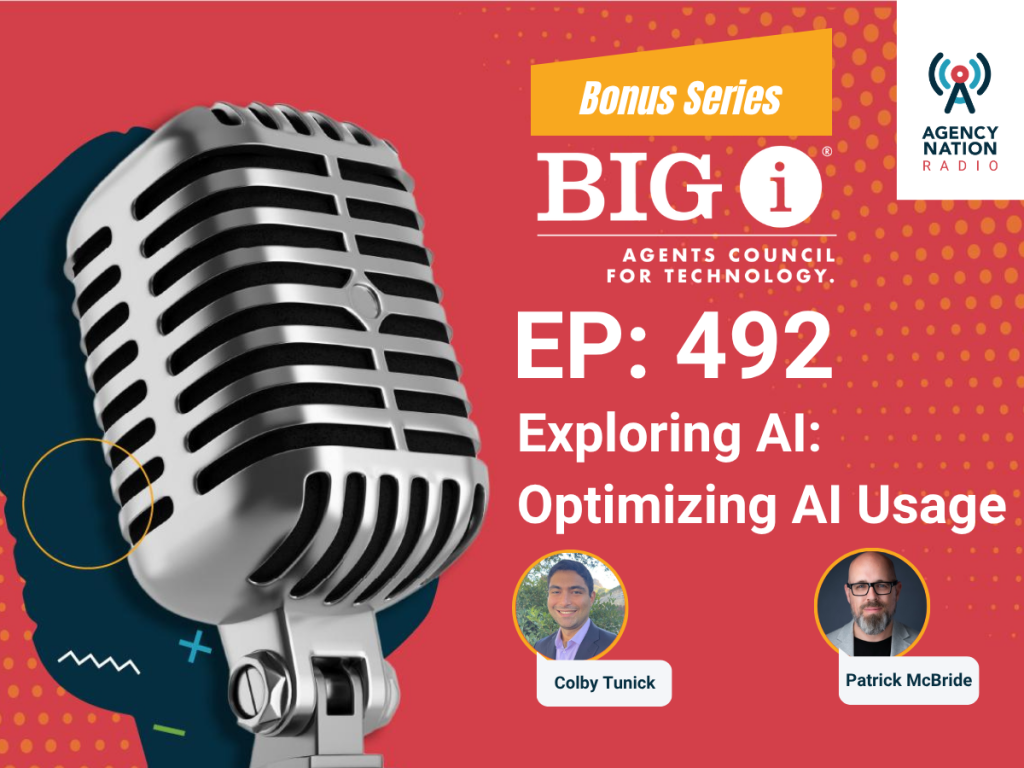7 Ways to Implement AI in Your Agency

By: AnneMarie McPherson Spears
Artificial intelligence (AI) in the insurance industry is inevitable—and when used correctly, can make independent insurance agents’ lives much easier. It’s crucial for agents to understand AI’s impact and proactively take ownership of its implementation.
“The fact of the matter is the longer you wait, the more behind you’ll be,” says CJ Hutsenpiller, team leader at Hutsenpiller Insurance in Mt. Juliet, Tennessee. “It’s emerging now, you’ve got public access to it in many cases—you have to leverage that. Imperfect action beats perfect inaction every time.”
Here are seven steps agencies can take to implement AI solutions:
1) Test out free AI with no stakes. “ChatGPT is the best example—it’s free,” says Elliot Bassett, president of Ellerbrock-Norris in Omaha, Nebraska. “Learn it, understand what this basic tool can do. Ask it questions.”
Besides creating an OpenAI account to try ChatGPT, other options include Anthropic AI’s Claude—which Independent Agent magazine took for a test drive—Google’s Bard and a plethora of other programs that may have cropped up after the time of publication.
“Do not wait to figure out what this is and what it can do for you,” says Beth Z, founder of Your Nerdy Best Friend. “Even if in six months we don’t need ChatGPT itself and we have it built into all these other tools, don’t wait to try it and understand it.”
Additionally, as carriers and vendors begin incorporating this new technology into their systems, reach out and ask about AI implementation support to gather your options. “It’s crucial to engage in open communication with carriers and with industry peers to gain insights and support before implementing an AI strategy,” says Sean Erikson, vice president of enterprise architecture, IT strategy, emerging tech and enterprise automation at Grange Insurance.
2) Analyze your use cases. It’s unadvisable to jump into the deep end of the pool, Hutsenpiller says. “Find one thing in your agency that’s an annoyance and that everyone hates doing.”
“It could be something that is costing your agency a lot of money or costing your team a lot of time,” adds Ilya Filipov, general manager at Total Expert.
And it should be an area with very little risk. “You’re building your capabilities and muscles along the way, and there’s going to be all kinds of lessons learned,” Erikson says.
3) Organize and protect your data. If your AMS is a mess, then you’re starting out three steps behind. “Ensure that the agency’s data collection strategy and storage process is robust enough to allow AI to be optimized,” Erikson says.
To address concerns around third-party AI programs and security, data encryption and data anonymization are key strategies. “Encrypting data both in transit and at risk ensures that even if data is intercepted it remains unreadable without the encryption key,” Erikson says. “And as people become more adept at providing meaningful prompts to LLMs like ChatGPT, it’s really important you think about data anonymization—that way if there’s a breach or leak the data would be of limited use.”
Data loss prevention (DLP) tools “can detect and prevent unauthorized attempts to transfer sensitive data outside the organization, and there are tools agents can use on their network to make sure that data doesn’t make its way outside of your network,” Erikson adds.
4) Set a policy. “What’s happening right now is people who are using ChatGPT feel like they’re cheating so they don’t tell anyone, and you also have people who are hanging back and waiting for guidelines,” Beth Z says. “You have to set up what makes sense for you.”
“What limitations do you want to put on the kind of information that ends up in ChatGPT?” she continues. “How are you making sure the information is truthful? Every time I put my name in ChatGPT, it knows who I am … and then it says I wrote books I didn’t write … and then it says I have a Pulitzer, which isn’t true—yet. It lies like a rug sometimes.”
Even while empowering the Ellerbrock-Norris team with LLM tools, “without at least some form of oversight there can certainly be risk on how it’s used,” says Andy Bassett, CEO of Ellerbrock-Norris. “How are you cross-referencing information? What’s the oversight?”
5) Carefully select your AI tools. “There’s lots of technologies out there,” Erikson says. “Select AI technologies and tools that will align with the agency’s specific needs and objectives. And fostering collaboration and partnership with technology providers is essential for seamless integration as well.”
As tools are implemented by carriers and vendors, “agents are going to see more and more of this being embedded into workflow solutions that they already own,” says Rich Belanger, chief technology officer at Applied. “And a lot of large software companies are looking at AI capabilities as an extra-cost option to add value to their products.”
The excitement and challenge of adopting emerging technology is “these AI tools are going to be coming out, there’s going to be a lot of them, and there’s going to be a lot of failures,” says Brad Ruben, president of Archway Computer. When looking at AI providers, “the key thing I always tell our clients is don’t sign a long-term agreement, because you have no idea what you’re getting into.”
6) Train employees. “Agency staff needs to be involved in the entire process and well-versed in using these tools,” Filipov says. “They need to understand how these complement their activities, and when they need to step in with the human touch.”
Employee training is not only important for efficiency, it’s also a critical part of data security. “Conduct regular security assessments and educate employees about data security best practices and potential risks associated with AI,” Erikson says. “And bad actors’ techniques with social engineering and phishing will only get more sophisticated with technology like ChatGPT, so it’s really important agencies make security part of their cultural narrative.”
7) Monitor and optimize. Ongoing thoughtfulness around AI in agencies includes “customer feedback, any incidents, and additional tools that will complement the process,” Filipov says.
With fine-tuning and tweaking, the learning capabilities of AI unlock vast possibilities for agents around customized systems. “We provide general tools, but an agency that’s in the Pacific Northwest that specializes in autos and art will have very different needs than an agency in Florida that’s focused on high-end homes,” Belanger says. “You’re going to get the most bang for your buck out of these tools with AI’s ability to take the information you feed it and learn about what works for you.”
AnneMarie McPherson Spears is IA news editor.
The image in this article was generated using DALL-E, OpenAI’s generative AI model.










